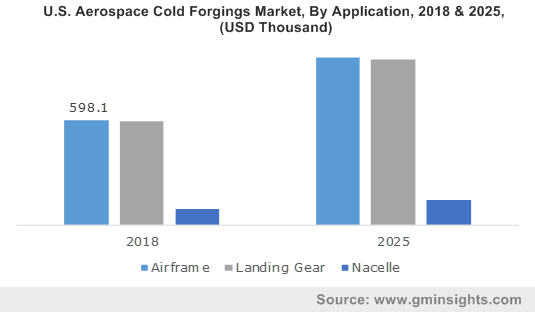Aerospace cold forgings market to register unprecedented momentum by 2025 driven by increasing air travel
Publisher : Fractovia | Published Date : 2019-07-22Request Sample
The growth of the global aerospace cold forgings market is likely to be led by exponentially increasing aircraft production and with rising focus on mitigating malfunctions to prevent catastrophic events worldwide.
In the aerospace industry, precision and durability are critical with every used component, as the slightest malfunction could cause death of hundreds of people onboard. Hence, to develop high-efficiency components, OEMs mainly prefer cold forging method as it helps reduce defects or folds in precious alloy parts. The components formed can also endure extreme environmental condition and offer benefits like high volume production, easy development of complex components like external engine parts, ducting, acoustic panels and engine cowl skins, improved tensile strength and lower production cost.
U.S. Aerospace Cold Forgings Market, By Application, 2018 & 2025, (USD Thousand)

The multifaceted benefits offered by the process are expected to encourage procedure adoption and will augment aerospace cold forgings market trends.
The landing gears segment in aerospace cold forgings market is expected to account for significant growth over the forecast period. OEMs in the aircraft manufacturing sector use cold-forged titanium alloys for forming aircraft landing gear owing to its high ductility and optimum yield strength. Higher strength metal alloys have also proven to be equally transformative for other aircraft components.
With cold-forged steel and titanium alloys, stronger and lighter landing gear structures can be made whilst further reducing aircraft weight, potential cases of corrosion as well as manufacturing cost. Moreover, obligatory compliance with strict regulations regarding upgradation of existing landing gears on aging fleet is anticipated to augment aerospace cold forgings industry size in the coming years.
The immense increase in air travel has led to manufacturing and replacement of aging aircraft fleets with newer, lightweight and fuel-efficient models. Reports from the International Air Transport Association (IATA) estimate that the present trends in air transport for passenger numbers could double to 8.2 billion in 2037. Moreover, the forecast anticipates a 3.5% CAGR over the next two decades which will lead to doubling in passenger numbers from current figures.
Thus, with such projected increase in air travel, airline operators are constantly demanding for newer fleets that cope with stringent emission and safety standards as well as offer a competitive lead in the market space. For instance, in April 2018, American Airlines purchased 47 new Boeing 787s aircraft to replace aging widebody models. Moreover, in July 2018, Jet Airways ordered 75 new Boeing 737 Max aircrafts to deal with ongoing demands. Investment trends such as these will encourage aircraft production and in turn boost aerospace cold forgings industry growth over the forecast timeframe.
The aerospace cold forgings market for narrow body platform will record significant gains over the coming years. The segment has witnessed increased demand lately owing to growth in commercial air transportation and demand for long-haul flights. Narrow body designs help increase range and efficiency of any aircraft, allowing it to offer improved competence and lower cost per available seat mile (CASM) to operators. Speculating these benefits, OEMs are also focusing more on developing narrow body airplanes.
For instance, Boeing’s new, fourth-generation 737 called the 737 MAX offers the greatest range in its family thanks to its advanced airframe upgrades and new CFM International LEAP-1B engines that offer long-distance travel of around 7400km with a passenger capacity of 150. Reports suggest that narrow body aircraft can also lower economic risks compared to wide body models and can offer reduced cost per available seat mile (CASM) than models like the Boeing 787-800. Development and demand of such aircraft models will ultimately augment aerospace cold forgings industry outlook over 2019-2025.
The North America aerospace cold forgings market is speculated to witness unprecedented growth due to the presence of leading aircraft manufacturers across the region. The growing demand for new aircraft models along with an expanded network of routes served by several airliners will support industry growth. Additionally, market players, expanding their manufacturing facilities to improve industry share, will also add impetus to aerospace cold forgings market expansion. For instance, in January 2019, Airbus unveiled its new production facility in the U.S. to fulfill the expansive demand for its A220 aircrafts.
Cold forging is a manufacturing process performed at room temperature where materials are subjected to extreme pressure to change their shape and size are per need. In the aerospace sector, the process helps ensure that all the aircraft components are made precisely and meet desired durability and regulatory standards. Reports from Global Market Insights, Inc., estimate that the aerospace cold forgings market will exceed $5.5 million by 2025.